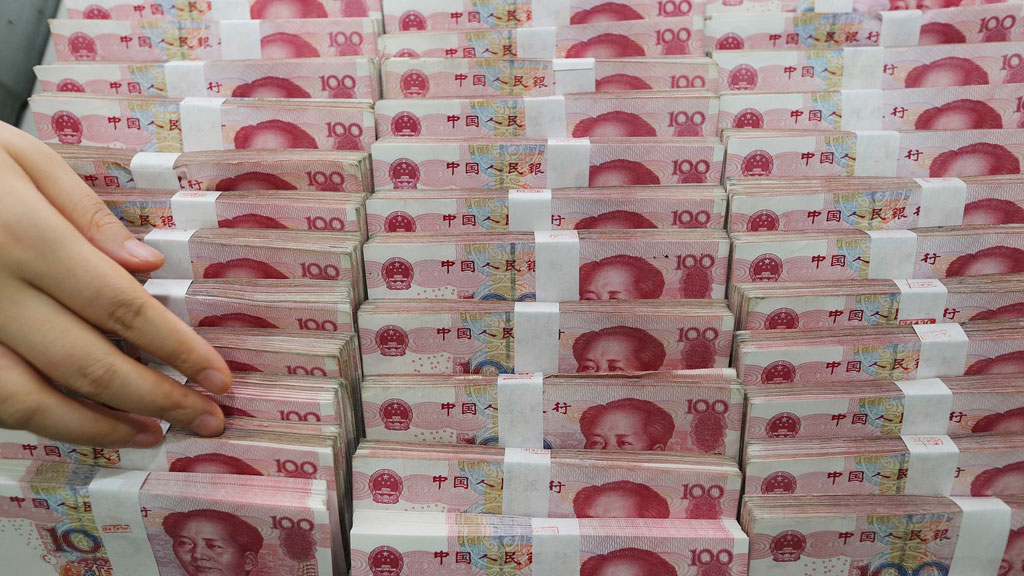 SHANGHAI: China's yuan inched down against the dollar on Friday as nervous traders awaited Beijing and Washington's next moves in their bruising tariff dispute, but markets were generally calmer after a sharp slide early in the week sparked fears of a global currency war.
SHANGHAI: China's yuan inched down against the dollar on Friday as nervous traders awaited Beijing and Washington's next moves in their bruising tariff dispute, but markets were generally calmer after a sharp slide early in the week sparked fears of a global currency war.
Onshore spot yuan finished the domestic session down 0.1pc at 7.0520 per dollar, its weakest such close since March 2008.
If it ends at the same level in late trading, it will have lost 1.6pc against the greenback this week, its worst such loss since June 2018.
China let the yuan slide past the key 7 per dollar level on Monday for the first time since the global financial crisis, days after the United States threatened to slap a 10pc tariffs on $300 billion of Chinese goods.
In the offshore market, the yuan crossed the 7 barrier for the first time ever, hitting a record low.
However, signs began to emerge on Tuesday that Beijing was looking to stabilise the currency after the initial shot across Washington's bows.
Mid-point fixings in the last few days have been successively lower but not as weak as traders expected, while source said state banks have been active in forward markets.
"In the near term, we think the yuan will trade in a range of 7.00 to 7.10," economists at ING said in a note on Friday.
"Further weakness would send a signal that China wants to start a currency war, which we strongly believe is not the case because this would do little to benefit the Chinese economy as other Asian currencies would just weaken along with the yuan."
However, ING cautioned there is a chance the yuan could fall further if the trade war continues to escalate.
Reuters forecasts show that the CFETS yuan index, which measures it against a basket of currencies, also broke a new low of 91.83 on Friday.
BACK TO SUPPORT MODE FOR NOW
The People's Bank of China set the mid-point, which limits the yuan's onshore movement, at 7.0136 per dollar on Friday, 97 pips weaker than the previous fix and at the lowest since 2008 for a second consecutive session.
The fixing was still stronger than what traders expected, with market participants increasingly starting to see the yuan trading around a new normal of 7.
"By and large, the market has digested this," said one trader in Shanghai with a foreign bank. "It doesn't mean the currency won't bounce back, though in the short term, there are still a lot of risks and uncertainty in the trade talks."
Washington is delaying a decision about licences for US firms to restart trade with Huawei Technologies, according to Bloomberg, while US Senator Marco Rubio urged the White House on Thursday not to allow exception to the ban.
A second Shanghai-based trader said trade talks that were scheduled for September in Washington, prior to the latest US tariff threat, now seem unlikely, adding further pressure on the Chinese currency.
"Short-term exchange rate does not have a lot to do with the fundamentals, it's much affected by the sentiment, it's very volatile, and not in a linear relationshiop," Guan Tao, a former director of the international payments department at China's State Administration of Foreign Exchange, the currency regulator.
"Compared with what the central bank did following the reforms in August 2015, it is communicating with the market in a more proactive and open manner. And in a certain extent, it has helped smoothing market sentiment to avoid panic."
China devalued the yuan in 2015 in an attempt to curb depreciation pressure, stunning global markets. It burned through $1 trillion in reserves before it steadied.
But if the US Federal Reserve carries on lowering interest rates and widening the gap between US and Chinese interest rates, the yuan may climb back to the stronger side of 7 per dollar, according to Ji Tianhe, China head of foreign exchange and local markets strategy at BNP Paribas in Beijing.
"Interest rate differential was an important factor leading the yuan depreciation against the dollar last year as yields between China and the United States shrunk sharply," he said.
The yield gap between Chinese and US benchmark 10-year government bonds stood at 134 basis points on Friday afternoon, compared with a low of 28 basis points hit in November.
Markets are pricing in another Fed cut of the same size next month, and another identical move the month after.
As of 0830, the offshore yuan was trading at 7.0795 per dollar, almost flat on the day.



















Comments
Comments are closed.